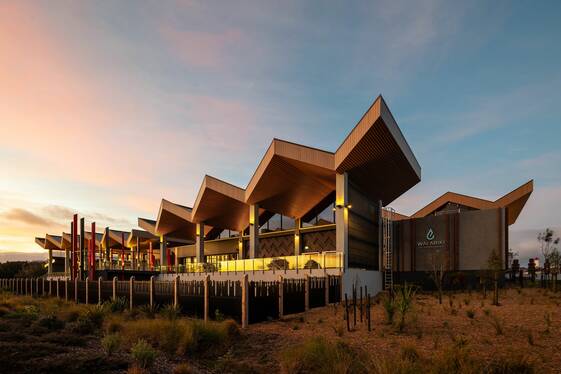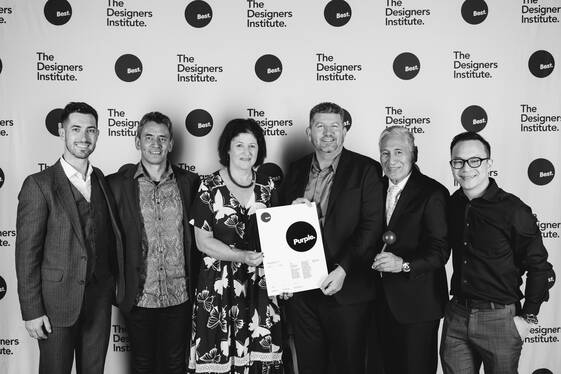The very best project in each discipline at the Best Design Awards is awarded the supreme, Purple Pin for work that truly raises the bar for New Zealand design.
Purple Pin Case Study — Spatial
RDG Ltd
Wai Ariki



Purple Pin 202
Spatial: Wai Ariki
Studio: RCG Ltd
Judge's comments
Wai Ariki exemplified that combination of high-quality design coupled with a respect and acknowledgement for Te Ao Māori design paying homage to craft and how that influences the story telling aspects of the design.
This project stands as a cultural and architectural masterpiece, seamlessly blending Ngāti Whakaue's rich cultural heritage and healing practices with a stunning geothermal design, creating an immersive and sustainable spa experience that positions Rotorua as a global wellness capital.
This design masterfully weaves together indigenous cultural heritage, architectural innovation, and immersive wellness experiences, creating a sanctuary that harmonizes natural geothermal elements, cultural narratives, and community aspirations into a transformative and sustainable spa destination.
Description
The Internationally renowned spa heritage of Rotorua, and legacy of Ngāti Whakaue culture, healing practices and manaakitanga, stretches back over 650 years. Ngāti Whakaue has welcomed visitors to the area to immerse themselves in its medicinal and wellbeing properties since the early 1800’s, and now aspires to position Rotorua as the Health Spa and Wellness capital of the world.
The brief was to create a luxury wellness facility like no other – architecturally, experientially and culturally – to provide ongoing value and future opportunity for Ngāti Whakaue members and the local community. The development was funded by Māori, to be led by Māori, and benefits from being compiled through the lens of Te Ao Māori. They aimed to curate an experience which both harnesses the areas strong and sensory geothermal properties whilst also imbedding authentic Ngāti Whakaue cultural narratives to enrich the journey of Manuhiri.
The result? Wai Ariki, the chiefly waters.
The architectural beacon is inspired by Ngāti Whakaue cultural narratives, infused with local whakairo, captured through a volcanic palette, and guided by Ngāti Whakaue as Mana Whenua – creating authentic and immersive geothermal bathing and healing experiences.
The distinctive architectural expression is underpinned by its strong roof form. Read as the brow of a Te Arawa waka, a whare gable, tectonic plates. A conversation between function, geology, climate and culture. The roof as such, performs a major role with shelter and is a significant architectural and placemaking opportunity.
The plan follows the experience, it is non-linear, and often spiralling – reflective of the Māori view of space and time.
The incredibly complex 4500m² structure floats above its highly active geothermal bed and is arranged by 2 key journeys– Te Wai Whakaora (The Restorative Journey) and Te Āhuru Mōwai(The Sanctuary).These are bisected by TiroTiro Whetū,(The Stargazing Pool). The Te Wai Whakaora journey is derived from the story of Ngātoroirangi, a high priest of Te Arawa, who called on life-saving geothermal heat when he was close to perishing on the ice of Mt Tongariro.
This kōrero is told and amplified through the senses – the soft songs of Ngāti Whakaue,the loud scents of the forest and native herbs, the piercing steam of the Kohu Wai Ariki, the bracing cold of Ice, the stickiness of the thermal mud.
The materiality of the building and interior read as a continuation of the landscape, that resonates with the local palette and histories of the site. The raw volcanic tones envelop the internal viewshafts towards Lake Rotorua. Scoria, obsidian and basalt dress many surfaces, but are often softened underfoot by geothermal heating.
The spa is a living biophilic and sustainable space, which uses natural geothermal water in the pools, to heat the underfloor, to heat the indoor air as well as to heat the domestic water supply. The concrete floor is also used as a giant heat sink to temper the water before it enters the pools.
In peak, over 90 jobs have been created, with a large percentage being Ngāti Whakaue.